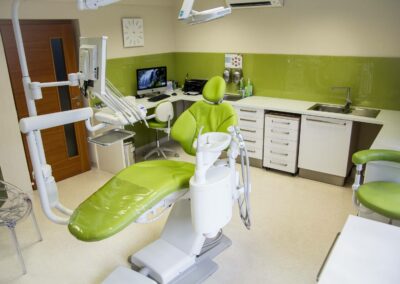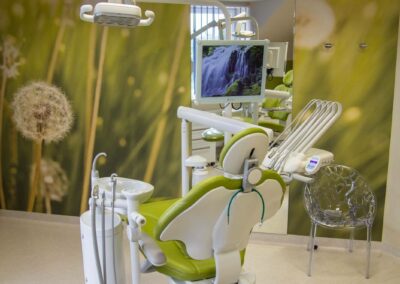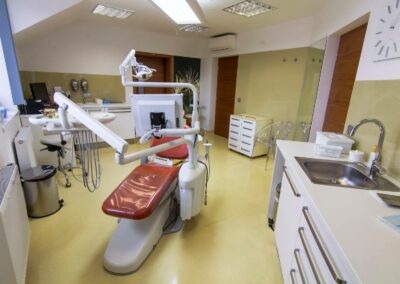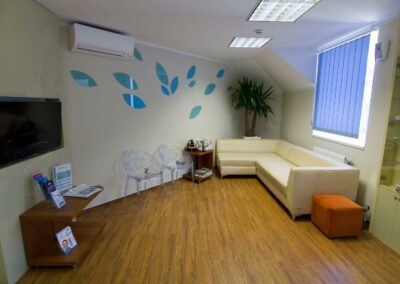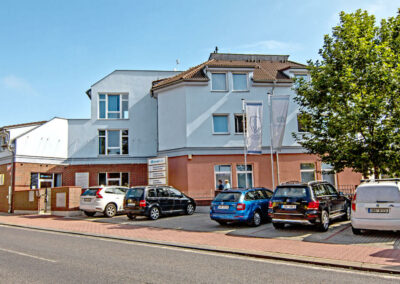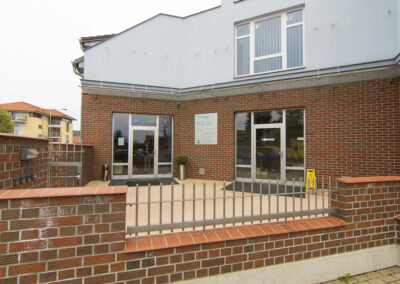Aesthetic dentistry
The concept of aesthetic dentistry appeared naturally with the development of dentistry. Previously, the treatment was considered to be of good quality if it was able to satisfactorily restore the function of the damaged tooth, and the patient was without problems for a long time. Today, only few people can be satisfied with the fact that dark dental fillings or unnatural-looking dental crowns are visible when they smile. A natural smile is a trend of modern aesthetic dentistry.
At a dental surgery, a dentist most often works with two aesthetic materials that can be called white fillings. These are photocomposite materials and glass ionomer cements. They are used to replace hard dental tissues in the treatment of tooth decay or a tooth damaged by an accident. White fillings have very different properties, so it is good to know a little about them.
Services provided
White filling (photo composite filling)
Photocomposite fillings clearly have the best aesthetic and functional properties. The advantage of these materials is a wide range of colour shades and degrees of translucency. Thanks to this, we are able to faithfully imitate the structure of a natural tooth so that the white filling is virtually invisible in the mouth. The color fastness and polishability of the white filling are at a very high level; even the mechanical properties are very similar to hard dental tissues. Thanks to the strong adhesive bond that connects the white filling to the tooth, it is not necessary to prepare any grooves in the tooth, unlike amalgam, when the filling is wedged into grooves to protect it from falling out. Modern dental procedures allow us to make maximum use of the potential of these materials, and thus we are able to reconstruct even extensive losses of dental tissues with a very good aesthetic and functional result.
Unfortunately, all good things come to an end, and this is also the case with the list of positive properties of photocomposite fillings.
In most cases, the negative properties of white fillings are caused by failure of the adhesive bond with the tooth. A white filling is quite demanding in terms of fabrication technique and subsequent care. If you do not follow the correct procedure for making a white filling, or if you neglect oral hygiene, the bond to the tooth can easily fail and a crack may appear. This is then populated by dental plaque microorganisms, causing caries. It spreads relatively quickly because the photocomposite material has no protective effects like in the case of glass ionomer (see below). In order to avoid this failure, it is necessary to fulfill the following two conditions: perfect oral hygiene and a high-quality white filling prepared using modern procedures.
Do you want to know how we proceed in making a white photocomposite filling?
White filling (glass ionomer cement)
This material is popularly used in paediatric patients for the treatment of dental caries. Compared to a photocomposite filling, there is no need to ensure absolute dryness using a rubber dam. On the contrary, it tolerates a wetter environment better, but this does not mean that a dental filling can be inserted into a wet or dirty tooth. A great advantage of glass ionomer cement is its protective effect against tooth decay. Thanks to its chemical structure, the white filling allows the continuous release of fluoride ions, which suppress the cariogenic (decay-promoting) activity of dental plaque bacteria. After the teeth are cleaned, the ion level in the mouth increases and the dental filling absorbs the ions again. One can say that the glass ionomer filling acts as a reservoir of protective fluoride ions.
However, this protective effect is not 100% reliable; it has more of a supporting function. The dental filling should be kept in a clean environment, free of all dental plaque. Only in this way can we be sure that tooth decay will not occur again.
Glass ionomer cement is not used only in children, but can also be used in adults. The advantage is that it creates a relatively strong chemical bond to the tooth, and therefore it is not necessary to weaken the tooth by preparation into which the filling would be wedged.
In adult patients, however, it is most often used only as a long-term temporary material. This can be attributed to the negative properties of the glass ionomer material, especially its low mechanical resistance and worse optical properties compared to photocomposite material.
Aesthetic dentistry does not only include white fillings, but we can certainly also consider all-ceramic restorations applied to the remaining teeth or to dental implants. Orthodontic treatment of crooked teeth also plays a role, and last but not least, also the care provided by dental hygiene.
The process of making a photocomposite white filling
Of course, all dental caries treatment with us is painless, and is performed under local anaesthesia. The dentist selects the colour of the filling material before the procedure. After that, the caries is removed and an absolutely dry working field is ensured. A rubber dam is used for this purpose. It is a latex membrane that is used by a dentist to isolate a tooth or a group of teeth from the moist environment in the mouth. This ensures that no saliva or blood gets on the surface of the tooth, which is necessary for the next procedure. This is followed by tooth surface preparation with acid gel and application of the bonding system. The latter saturates the tooth deeply, thus enabling a really solid connection of the white filling to the tooth. Thereafter, photocomposite material is applied in layers and each layer is carefully cured with blue light. Finally, the filling is processed and polished.
A white filling made in this way is highly aesthetic and functional, and with good oral hygiene, it is also stable in the long term.
Dental medical team
Assoc. Prof. Eva Gojišová, MD
chief doctor – dentistry
MUDr. Magdalena Koťová, Ph.D.
chief doctor – orthodontics
MUDr. Tomáš Hlaďo
specialist doctor – pediatric dentistry
MDDr. Petr Švácha
Dentist
MDDr. Martin Linka
specialist doctor – orthodontics
Contractual health insurance companies






Contact us
Ambicare Prague 4
recepce@ambicare.eu
K Hrnčířům 25, Praha 4
It is not possible to send text messages to the above phone numbers, please call or email us instead. Thank you for your understanding.






